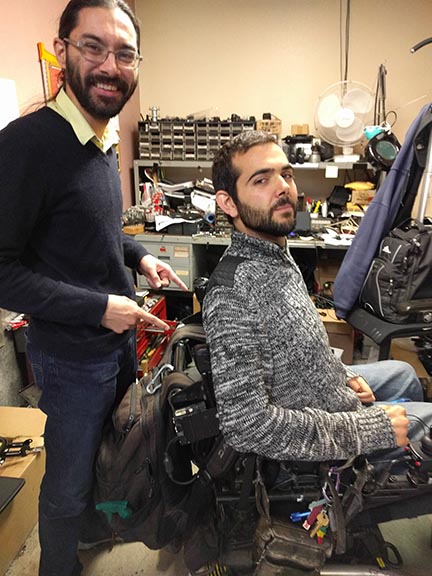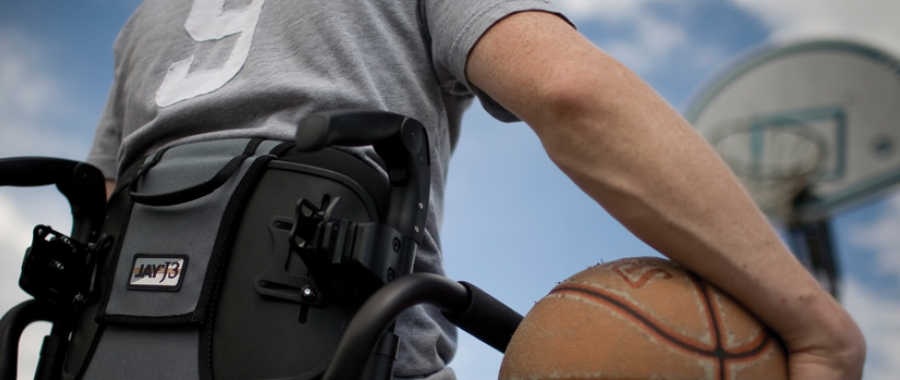In search of a better backrest
This past Tuesday, I rolled by my local wheelchair shop to make a small chair adjustment. I’ve recently been working with one of the staff members to rebuild my backrest in a way that would give me better posture, and I wanted one more tweak.

Hugh adjusting backrest for Alex Ghenis
By Alex Ghenis, New Mobility November 23, 2016
The transition all started about five months ago, when we upgraded from the stock curved pan (with a whole bunch of memory foam I put there using Gorilla Tape) that I’ve had for five years, to a Matrx Elite, a form-fitted model made by Invacare. Since then I’ve dropped in every now and then to add or move a piece of foam under the cover, shift the whole backrest up a half-inch, then shift it down the other way even more.
Each time it would feel a little bit more comfortable and Hugh, the backrest-adjuster, would send me off, saying, “Well, try that out for a bit and tell me what you think.”

Arturo Valdez with a customized Fusion cushion
| A little bit more shoulder freedom |
After the last adjustment, the backrest felt great but I just wanted a little bit more shoulder freedom, so I came back to see what we could do.
Luckily Hugh was in the shop and had 10 minutes, so we loosened a couple of bolts and dropped the whole thing down three-quarters of an inch, then added a palm-sized piece of foam right in the center. He told me to give it a try, and right when I leaned back I was sitting comfortably upright, breathing was easier, and my shoulder blades could move freely in circles. I even felt all the small muscles between my ribs stretch themselves free like never before, loosening up my rib cage and letting me move around in circles without trouble. Not only was it like I had a whole new chair — it was like I had a whole new upper body. All from a small piece of foam and a move of less than an inch.
Many of the backrests that come stock with wheelchairs are nothing special. For paras, they tend to sit pretty low with a little lumbar support and some are just curved pads, while others are a bit more formed. But for many higher-level or full-body disabilities (such as high-level spinal cord injury or progressive multiple sclerosis), people receive taller generic setups: the stock backrest on my tilt-recline Invacare, for example, was just a tall curved plastic pan with a thin layer of foam on it.
Sometimes these are okay, but they can also be uncomfortable or bad for posture (such as pushing shoulders forward and impeding range of motion), and can contribute to other conditions including scoliosis and pressure sores. Many people are content with the set up they get, even if it doesn’t feel great — but that might be because they don’t know they can actually get something better.

Wheelchair Cushions & Backs. ERAC
| Finally — the right backrest |
That was my situation five years ago. Because I didn’t think of a full upgrade, I tried to jerry-rig a solution. My old backrest was a curved stock plastic back, just like the back on my first wheelchair. It constantly pushed my shoulder blades forward and made me hunch-backed a bit.
I wouldn’t deal with it so I did the same thing as with the old one: I tried to fix it by taking a bunch of chopped up foam from old bed toppers, and building in a nice slow lumbar curve to hold me more upright. It didn’t feel too bad and was actually nice and cushy with the memory foam.
But then a few months ago, Hugh, the guy at the wheelchair shop, mentioned that we could try something better. I got the right doctor’s note and we ordered the new Matrx Elite model, then spent some time to tweak it so it gave my shoulders freedom and hit the lumbar support in just the right way. It took several months to get it right, but once we lowered down the backrest so that the top was just under my shoulder blades and added enough lumbar support in the right spot, it opened up my whole body so that now I can move around like never before.
With the right doctor’s note, Medicare will pay for one backrest upgrade – and many other insurances are the same. But a lot of new backrests can be moved up and down, and have their curve modified with well-placed foam secured in the right way under the cover.
Your local wheelchair shop likely has a staff member who works on posture issues with clients, so I highly recommend talking to them about your options and give it little tweaks over time to see what works well. Or you can try tweaking it on your own, buying foam from a hardware store or elsewhere.
If you get it right, it will improve your posture, your range-of-motion, and just how you move in general. And I’m not joking when I say that it will change your life.
![]() Source New Mobility
Source New Mobility
| References |
Comparing the effects of different dynamic sitting strategies in wheelchair seating on lumbar-pelvic angle, Chun-Ting Li, Yao-Te Peng, Yen-Ting Tseng, Yen-Nien Chen and Kuen-Horng Tsai. BMC Musculoskeletal Disorders 201617:496 DOI: 10.1186/s12891-016-1358-3
Also see
Wall-Mounted TV: The Giant Monitor that Saved my Posture New Mobility
5 “Quad Tricks” for Managing a Day at Home Solo New Mobility
Achieve optimum seating outcomes with Ride wheelchair back supports Ride Designs
3 Backrest Options to Enhance the Ultra Lightweight Manual Wheelchair Experience Sunrise Medical
My Experience as an Active Quickie Q7 Wheelchair User LOH Medical
